
Lipotidae is a family of river dolphins containing the functionally extinct baiji of China and the fossil genus Parapontoporia from the Late Miocene and Pliocene of the Pacific coast of North America. The genus Prolipotes, which is based on a mandible fragment from Neogene coastal deposits in Guangxi, China, has been classified as an extinct relative of the baiji, but is dubious.
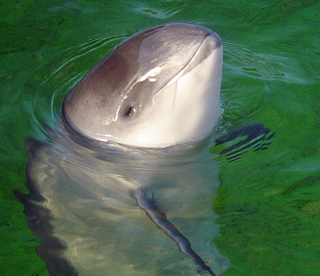
Phocoena is a genus of porpoises with four extant species:

Tube-dwelling anemones or ceriantharians look very similar to sea anemones but belong to an entirely different subclass of anthozoans. They are solitary, living buried in soft sediments. Tube anemones live inside and can withdraw into tubes, which are composed of a fibrous material made from secreted mucus and threads of nematocyst-like organelles known as ptychocysts. Within the tubes of these ceriantharians, more than one polyp is present, which is an exceptional trait because species that create tube systems usually contain only one polyp per tube. Ceriantharians were formerly classified in the taxon Ceriantipatharia along with the black corals but have since been moved to their own subclass, Ceriantharia.
Jiutaisaurus is a genus of sauropod dinosaur from the Quantou Formation of Xidi, China. Jiutaisaurus was a sauropod which lived during the Cretaceous. The type species, Jiutaisaurus xidiensis, was described by Wu et al. in 2006, and is based on eighteen vertebrae. It probably lived alongside Changchunsaurus and Helioceratops.

Corallimorpharia is an order of marine cnidarians closely related to stony or reef building corals (Scleractinia). They occur in both temperate and tropical climates, although they are mostly tropical. Temperate forms tend to be very robust, with wide and long columns, whereas tropical forms tend to have very short columns with a wide oral disc and very short tentacles. The tentacles are usually arranged in rows radiating from the mouth. Many species occur together in large groups, although there are recorded instances of individuals. In many respects, they resemble the stony corals, except for the absence of a stony skeleton. Morphological and molecular evidence suggests that they are very closely related to stony corals.
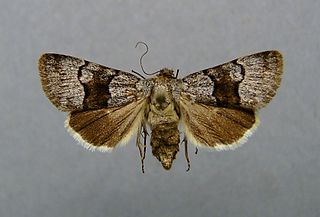
Sympistis is a genus of moths of the family Noctuidae. The genus was erected by Jacob Hübner in 1823.

The Helosciomyzidae are a small family of flies - 9 genera and 22 species. All are known from the Southern Hemisphere. With the exception of the South American genus Sciogriphoneura, the family occurs in Australia, New Zealand. Little is known of their biology.

Hellinsia is a genus of moths in the family Pterophoridae.
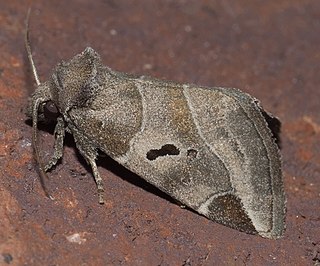
Stiriinae is a subfamily of owlet moths in the family Noctuidae. There are more than 20 genera and 130 described species in Stiriinae.
Nephroisospora is a genus of parasites that infects bats
Zarhinocetus is an extinct genus of whale from the Early to Middle Miocene of the eastern North Pacific.
Kallidontus is an extinct genus of conodonts.
Liolithax is an extinct genus of dolphin from the Middle Miocene (Serravallian) Temblor Formation of California.
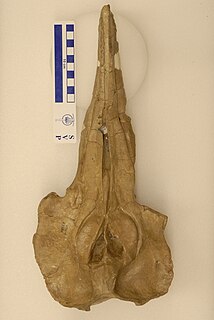
Lophocetus is an extinct genus of dolphin belonging to the clade Delphinida that is known from late Miocene (Tortonian) marine deposits in California and Maryland. Although usually placed in Kentriodontidae, recent studies have found it only distantly related to Kentriodon.
Lineostriastiria hutsoni is a species of moth in the family Noctuidae. It is found in North America.
Lineostriastiria olivalis is a species of moth in the family Noctuidae. It was first described by William Barnes and James Halliday McDunnough in 1916 and it is found in North America.
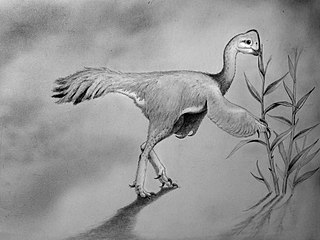
Leptorhynchos is an extinct genus of caenagnathid dinosaurs known from the Late Cretaceous Aguja Formations of west Texas United States. It lived about 80.5–72 million years ago. It is distinguished from its relatives Chirostenotes and Anzu by its smaller size, and by a more strongly upturned mandible, similar to that of oviraptorids. The specializations of the beak in Leptorhynchos and other caenagnathids suggest that they were herbivores. The species L. elegans has since been transferred to the genus Citipes, leaving only the type species L. gaddisi in the genus.
William David Barnes was an American entomologist and surgeon. He was the son of Dr. William A. and Eleanor Sawyer Barnes. He graduated salutatorian from the Decatur High School in 1877. Then spent a year at Illinois State University followed by a year at University of Illinois at Urbana–Champaign. In 1879, he entered Harvard Medical School and graduated in 1886. While at Harvard, he met naturalist Louis Agassiz and his love of Lepidoptera grew. Agassiz taught him how to preserve and classify the butterflies. He completed an internship at Boston City Hospital and then studied abroad in Heidelberg, Munich, and Vienna. In 1890, Dr. Barnes came home to Decatur and opened his medical practice. That same year he married Charlotte L. Gillette. The couple had two children: William Barnes Jr., and Joan Dean Gillett Barnes.

Citipes is an extinct genus of caenagnathid dinosaurs known from the Late Cretaceous Dinosaur Park of southern Alberta, Canada. It lived about 76.9–75.8 million years ago. The specializations of the beak in Citipes and other caenagnathids suggest that they were herbivores. The type species, C. elegans had been previously placed within the genera Chirostenotes, Elmisaurus, Leptorhynchos and Ornithomimus.










